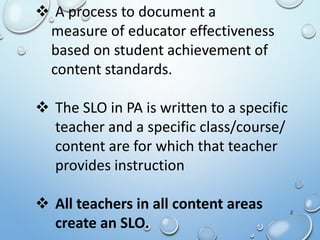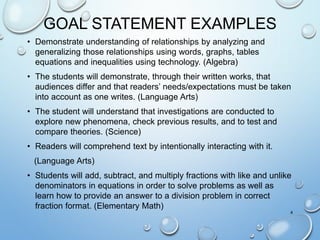SLO ppt 1
- 2. 2 A process to document a measure of educator effectiveness based on student achievement of content standards. The SLO in PA is written to a specific teacher and a specific class/course/ content are for which that teacher provides instruction All teachers in all content areas create an SLO.
- 3. GOAL STATEMENT • A goal statement is a narrative statement that is…. o Reflective of the “big ideas” of the course/grade/subject. o Based on several topics or concepts. o Fostering student success now and for the future. o Derived from the most important learning. o Extends beyond students’ current course/grade/subject. • A goal statement is NOT…. o A list of specific learning objectives. o Based on one or two lessons. o Limited to one course/grade/subject. 3
- 4. GOAL STATEMENT EXAMPLES • Demonstrate understanding of relationships by analyzing and generalizing those relationships using words, graphs, tables equations and inequalities using technology. (Algebra) • The students will demonstrate, through their written works, that audiences differ and that readers’ needs/expectations must be taken into account as one writes. (Language Arts) • The student will understand that investigations are conducted to explore new phenomena, check previous results, and to test and compare theories. (Science) • Readers will comprehend text by intentionally interacting with it. (Language Arts) • Students will add, subtract, and multiply fractions with like and unlike denominators in equations in order to solve problems as well as learn how to provide an answer to a division problem in correct fraction format. (Elementary Math) 4
- 5. Student Learning Objectives Information 5 All information is available on the PDE SAS webs http://www.pdesas.org
- 6. USEFUL LINKS •PDE portal containing SLO information • HTTP://WWW.PDESAS.ORG/INSTRUCTION/STUDENTLEARNINGOBJEC TIVES •End of Year expectation for grades k-2 • HTTP://CCSDPROFDEV.WIKISPACES.COM/SLO •PA. Core Standards for grades 3-6 • HTTP://WWW.PDESAS.ORG/STANDARD/PACORE 6
- 7. PA-ETEP LINK •You must access the PA-ETEP website through Crawford Central’s link. • HTTP://WWW.CRAW.ORG/DISTRICTRESOURCES.ASPX 7
- 8. STANDARDS • The standards that most directly apply and connect to the goal. • Supply a brief description of each standard. • Pennsylvania may not have standards for your content. use the standard system that is approved by your LEA. • Should not be a laundry list of every standard for the course/grade/subject, but the ones that best align to the goal. 8
- 9. Rationale Statement • Narrative providing reasons why the goal and standards statements address the essential learning for the class. • There was a reason the goal statement was selected and/or developed, state that reason. 9
- 10. PUTTING IT TOGETHER 10 EXAMPLE: Elementary Math Template Example
- 11. PM and PI • PM : Performance Measure • You must have at least two different assessments that assess your goal. Don’t put all your eggs in one basket. • PI : Performance Indicator • What score you think the students need to get to be successful? Success could be defined as Proficient or Advanced. 11
- 13. WHAT DO YOU WANT TO MEASURE AND WHY? 13 Purpose of Chosen Assessment o Who/What and Why o Explain the reason the assessments were identified Choosing a Metric o Mastery- This is a set achievement goal o Growth- Improvement in performance over time o Growth and Mastery- Using one assessment for both
- 14. Identifying Performance Measures oAre my assessments aligned with what I am testing? oDo I have enough assessment items for each standard? oAre my assessment items rigorous enough? oIf my assessment is teacher created, were strong enough test development protocols used? 14
- 15. Identifying Performance Measures Principles of Well-Designed Measures • Be built to achieve the designed purpose • Produce results that are used for the intended purpose • Align to targeted content standards • Contain a balance between depth and breadth of targeted content • Be standardized, rigorous and fair • Be sensitive to testing time and objectivity • Be valid and reliable 15
- 16. EXAMPLE • Student will make 8 out of 10 free throws from the foul line. • In this example, mastery is set at 80%. • Make the goal attainable. • Here you would be setting the floor at 80%, students could always get more. 16
- 17. Choosing the Right Assessments • Think about everything that is available to you… • Teacher made • Vendor made • Identifying the assessment type… • Project or portfolio with a rubric for evaluation? • Standardized assessment • District or teacher created exams? • Identify what each assessment measures… • Does the assessment measure the targeted standards? • How many of the questions align to the standards targeted in the SLO? 17
- 18. DEVELOPING PERFORMANCE INDICATORS • Defining Performance Targets • Articulate the targets you wish your students to reach on the performance measures you identified in section 4 of the template. • Examples • Students will earn 80% or higher on the 3rd nine weeks district 5th grade math assessment • Students will earn 30 or more percentage points on the 4th grade language arts post assessment than they did on the pre-assessment –or-earn at least 85%. 18
- 19. EXAMPLE • Student will make 8 out of 10 free throws from the foul line. • In this example, mastery is set at 80%. • Make the goal attainable. • Here you would be setting the floor at 80%, students could always get more. 19
- 20. EXAMPLE 20 Scenario 1: You have 10 students on your basketball team. 3 shoot 4/10, 2 shoot 6/10, 3 shoot 8/10, 2 shoot 9/10 In this scenario 50% of the players reached the goal of 80% of shots made. Scenario 2: You have 10 students on you basketball team. What would success look like?
- 21. Teacher’s Levels of Projected Performance • The SLO process allows for a great deal of flexibility and control • The four teacher expectation levels are established by educators prior to the evaluation period. • Each performance level is populated with a percentage ranging from 0% to 100% distributed among all four levels. • The principal and teacher need to have a conversation about how the ranges were established. 21
- 22. Factors to Consider • How do you define proficiency? • Are you satisfied with the % of students meeting proficiency? • What data and decisions did you consider in determining your levels of scores? Helpful hints: • Use historical data, if available, in determining the percentage ranges. • Start with the range for the proficient level. 22
- 23. DUE DATE • Submit SLO via PA-ETEP no later than November 6 23






















